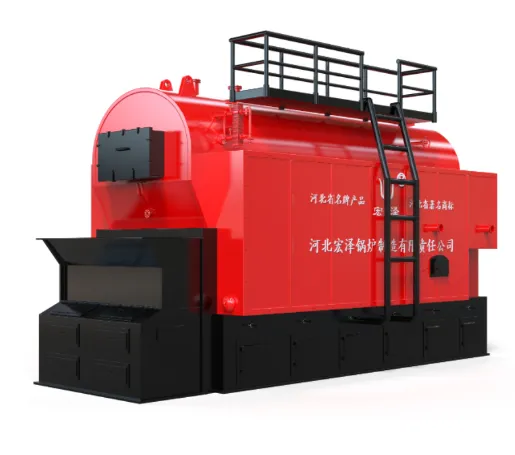
Mar . 04, 2025 07:39 Back to list
how does a biomass boiler work
Understanding how steam boiler systems work is crucial for anyone involved in industries or facilities that require heat generation. Steam boilers have been an essential component of thermal power applications across various industries. This article dives into the mechanics, functions, and applications of steam boiler systems, providing a comprehensive understanding based on real-world experience and professional expertise.
Steam is then transported through a network of pipes to its intended use, which could range from heating applications to driving turbines for electricity generation. In industrial settings, steam is even used for specific processes such as sterilization, refining, and chemical production. The versatility of steam is its ability to transfer energy efficiently across various applications. Moreover, the environmental impact of steam boilers has come under scrutiny, prompting developments in cleaner combustion technologies. Innovations such as low-NOx burners and biomass fuel options have been introduced to reduce the carbon footprint of steam production. These greener alternatives are becoming increasingly crucial as industries aim to meet stringent environmental regulations. Routine maintenance plays an indispensable role in the longevity and efficiency of a steam boiler system. Regular inspections, pressure tests, and cleaning procedures help prevent common issues such as scaling and fouling. The insights of experienced engineers underscore the importance of preventive maintenance to avoid costly downtimes and repairs—ensuring that the boiler performs optimally throughout its service life. The procurement of steam boiler systems demands thorough consideration of factors like operational requirements, fuel options, and efficiency ratings. Selecting a boiler involves not only assessing current needs but anticipating future demand. Energy efficiency has emerged as a significant factor in the decision-making process, guiding investments towards systems that promise lower operational costs and reduced environmental impact over time. In conclusion, the operation of steam boiler systems represents a complex interplay of engineering and technology geared towards efficient and safe steam production. Professionals in the field leverage a deep understanding backed by hands-on experience to maintain and improve these systems. Enhanced designs and cleaner technologies continue to evolve, driving the steam boiler industry toward greater efficiency and sustainability. This expertise, grounded in practice and continuous improvement, ensures that these systems reliably meet the diverse demands of modern industries.


Steam is then transported through a network of pipes to its intended use, which could range from heating applications to driving turbines for electricity generation. In industrial settings, steam is even used for specific processes such as sterilization, refining, and chemical production. The versatility of steam is its ability to transfer energy efficiently across various applications. Moreover, the environmental impact of steam boilers has come under scrutiny, prompting developments in cleaner combustion technologies. Innovations such as low-NOx burners and biomass fuel options have been introduced to reduce the carbon footprint of steam production. These greener alternatives are becoming increasingly crucial as industries aim to meet stringent environmental regulations. Routine maintenance plays an indispensable role in the longevity and efficiency of a steam boiler system. Regular inspections, pressure tests, and cleaning procedures help prevent common issues such as scaling and fouling. The insights of experienced engineers underscore the importance of preventive maintenance to avoid costly downtimes and repairs—ensuring that the boiler performs optimally throughout its service life. The procurement of steam boiler systems demands thorough consideration of factors like operational requirements, fuel options, and efficiency ratings. Selecting a boiler involves not only assessing current needs but anticipating future demand. Energy efficiency has emerged as a significant factor in the decision-making process, guiding investments towards systems that promise lower operational costs and reduced environmental impact over time. In conclusion, the operation of steam boiler systems represents a complex interplay of engineering and technology geared towards efficient and safe steam production. Professionals in the field leverage a deep understanding backed by hands-on experience to maintain and improve these systems. Enhanced designs and cleaner technologies continue to evolve, driving the steam boiler industry toward greater efficiency and sustainability. This expertise, grounded in practice and continuous improvement, ensures that these systems reliably meet the diverse demands of modern industries.
Share
Latest News
-
High-Efficiency Commercial Oil Fired Steam Boiler for Industry
NewsJul.30,2025
-
High-Efficiency Biomass Fired Thermal Oil Boiler Solutions
NewsJul.30,2025
-
High Efficiency Gas Fired Thermal Oil Boiler for Industrial Heating
NewsJul.29,2025
-
High-Efficiency Gas Fired Hot Water Boiler for Sale – Reliable & Affordable
NewsJul.29,2025
-
High Efficiency Biomass Fired Hot Water Boiler for Industrial and Commercial Use
NewsJul.29,2025
-
High-Efficiency Biomass Fired Hot Water Boiler for Industrial Use
NewsJul.28,2025
Related PRODUCTS
Copyright © 2025 HEBEI HONGZE BOILER MANUFACTURING CO., LTD. All Rights Reserved. Sitemap | Privacy Policy






















